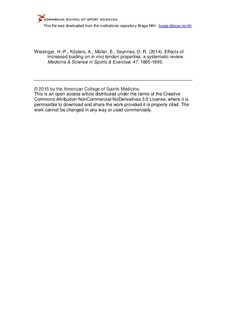| dc.contributor.author | Wiesinger, Hans-Peter | |
| dc.contributor.author | Kösters, Alexander | |
| dc.contributor.author | Müller, Erich | |
| dc.contributor.author | Seynnes, Olivier R. | |
| dc.date.accessioned | 2015-10-27T10:52:00Z | |
| dc.date.available | 2015-10-27T10:52:00Z | |
| dc.date.issued | 2015-09 | |
| dc.identifier.citation | Medicine & Science in Sports & Exercise. 2015, 47, 1885-1895 | nb_NO |
| dc.identifier.uri | http://hdl.handle.net/11250/2358097 | |
| dc.description | This is an open access article distributed under the terms of the Creative
Commons Attribution-NonCommercial-NoDerivatives 3.0 License, where
it is permissible to download and share the work provided it is properly
cited. The work cannot be changed in any way or used commercially. | nb_NO |
| dc.description.abstract | Introduction: In vivo measurements have been used in the past two decades to investigate the effects of increased loading on tendon properties, yet the current understanding of tendon macroscopic changes to training is rather fragmented, limited to reports of tendon stiffening, supported by changes in material properties and/or tendon hypertrophy. The main aim of this review was to analyze the existing literature to gain further insights into tendon adaptations by extracting patterns of dose-response and time-course.
Methods: PubMed/Medline, SPORTDiscus, and Google Scholar databases were searched for studies examining the effect of training on material, mechanical, and morphological properties via longitudinal or cross-sectional designs.
Results: Thirty-five of 6440 peer-reviewed articles met the inclusion criteria. The key findings were i) the confirmation of a nearly systematic adaptation of tendon tissue to training, ii) the important variability in the observed changes in tendon properties between and within studies, and iii) the absence of a consistent incremental pattern regarding the dose-response or the time-course relation of tendon adaptation within the first months of training. However, long-term (years) training was associated with a larger tendon cross-sectional area, without any evidence of differences in material properties. Our analysis also highlighted several gaps in the existing literature, which may be addressed in future research.
Conclusions: In line with some cross-species observations about tendon design, tendon cross-sectional area allegedly constitutes the ultimate adjusting parameter to increased loading. We propose here a theoretical model placing tendon hypertrophy and adjustments in material properties as parts of the same adaptive continuum. | nb_NO |
| dc.language.iso | eng | nb_NO |
| dc.publisher | American College of Sports Medicine | nb_NO |
| dc.subject | patellar tendon | nb_NO |
| dc.subject | achilles tendon | nb_NO |
| dc.subject | plasticity | nb_NO |
| dc.subject | dose-response relation | nb_NO |
| dc.subject | time-course relation | nb_NO |
| dc.title | Effects of increased loading on in vivo tendon properties: a systematic review | nb_NO |
| dc.type | Journal article | nb_NO |
| dc.type | Peer reviewed | nb_NO |
| dc.subject.nsi | VDP::Social science: 200::Social science in sports: 330::Other subjects within physical education: 339 | nb_NO |
| dc.source.journal | Medicine & Science in Sports & Exercise | nb_NO |
| dc.description.localcode | Seksjon for fysisk prestasjonsevne / Department of Physical Performance | nb_NO |
